The psoas muscle‚ a deep hip flexor connecting the spine to the femur‚ plays a crucial role in movement and posture. Stretching it can relieve tension‚ improve mobility‚ and enhance overall well-being.
1.1 What is the Psoas Muscle?
The psoas muscle‚ also known as the iliopsoas‚ is a deep‚ powerful muscle in the lower body. It originates from the lumbar spine‚ runs through the pelvis‚ and attaches to the femur (thigh bone). This muscle plays a crucial role in hip flexion‚ helping to lift the knee and support movements like walking‚ running‚ and sitting. The psoas is often referred to as the “seat of the soul” due to its connection to the spine and its influence on posture and overall physical alignment. Tightness or imbalance in this muscle can lead to discomfort and mobility issues‚ making stretching and strengthening essential for maintaining proper function.
1.2 Importance of Stretching the Psoas
Stretching the psoas muscle is essential for maintaining proper posture‚ reducing lower back pain‚ and enhancing athletic performance. Tight psoas muscles can pull the pelvis out of alignment‚ contributing to discomfort and limited mobility; Regular stretching helps to release tension‚ improve flexibility‚ and promote balanced muscle function. This can lead to better overall movement‚ reduced risk of injury‚ and enhanced physical comfort. Incorporating psoas stretches into a daily routine can significantly improve both physical and mental well-being‚ making it a vital practice for individuals of all activity levels.
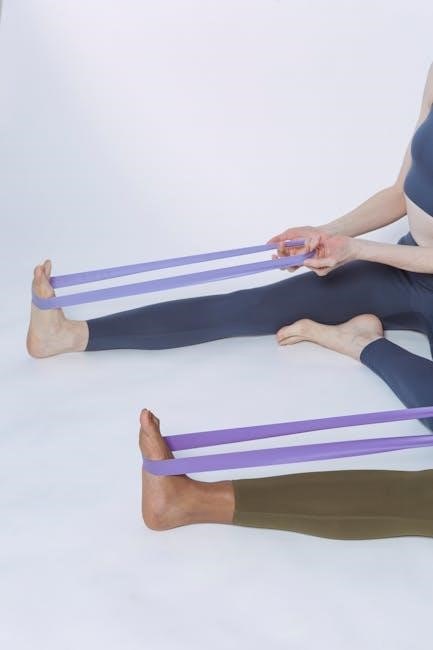
Benefits of Stretching the Psoas Muscle
Stretching the psoas muscle offers numerous benefits‚ including improved posture‚ reduced lower back pain‚ enhanced athletic performance‚ and injury prevention‚ promoting overall well-being;
2.1 Improved Posture
Stretching the psoas muscle can significantly enhance posture by reducing muscle imbalances in the lower back and hips. Tight psoas muscles often pull the pelvis forward‚ leading to an arched lower back and discomfort. Regular stretching helps relax the psoas‚ allowing the spine to align naturally and reducing excessive curvature. Improved posture not only alleviates strain on surrounding muscles but also boosts confidence and overall physical comfort. By incorporating psoas stretches into your routine‚ you can achieve better spinal alignment and maintain a healthier‚ more balanced posture throughout the day.
2.2 Relief from Lower Back Pain
Stretching the psoas muscle can provide significant relief from lower back pain by releasing tension in the hip flexors and improving spinal alignment. Tight psoas muscles often pull the pelvis forward‚ leading to strain on the lower back. Regular stretching helps relax the psoas‚ reducing pressure on the lumbar spine and alleviating discomfort. This can be especially beneficial for individuals with chronic lower back pain‚ as it promotes better muscle balance and reduces inflammation. Incorporating psoas stretches into your routine can help create a more stable and pain-free lower back‚ enhancing overall comfort and mobility.
2.3 Enhanced Athletic Performance
Stretching the psoas muscle can significantly enhance athletic performance by improving flexibility‚ range of motion‚ and power. Tight hip flexors often limit movement efficiency‚ which can hinder performance in sports and activities requiring rapid acceleration or quick changes of direction. Regular psoas stretches help relax the muscle‚ allowing for better stride length in runners‚ more powerful kicks in martial arts‚ and improved cycling efficiency. Additionally‚ reduced muscle tension can enhance overall muscle function‚ enabling athletes to perform at higher intensities with less risk of injury. Incorporating psoas stretches into training routines is a simple yet effective way to boost athletic capabilities and achieve better results.
2.4 Prevention of Injuries
Stretching the psoas muscle is an effective way to prevent injuries‚ particularly those related to the lower back and hips. Tight or imbalanced psoas muscles can lead to poor posture and altered movement patterns‚ increasing the risk of strains and overuse injuries. Regular stretching helps maintain balanced muscle function‚ reducing the likelihood of hip flexor strains and lower back discomfort. Additionally‚ by improving flexibility and range of motion‚ psoas stretches can enhance overall athletic performance and reduce the risk of injuries during physical activities such as running‚ cycling‚ or repetitive movements. Consistent practice promotes long-term joint health and stability.
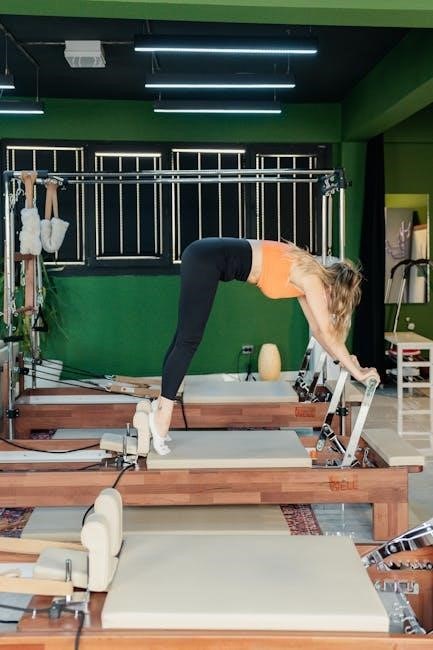
Types of Psoas Stretches
The psoas muscle can be stretched through various exercises‚ including kneeling stretches‚ prone stretches‚ lunges‚ and standing techniques. Each method targets the muscle from different angles to enhance flexibility and relieve tension.
3.1 Kneeling Psoas Stretch
The kneeling psoas stretch is an effective exercise to release tension in the psoas muscle. Start by kneeling on one knee with the other foot forward‚ keeping your spine straight. Gently push your hips forward until you feel a stretch in the front of your hip. Hold this position for 20-30 seconds and repeat on the other side. This stretch improves hip flexibility and reduces lower back strain. It’s often recommended in psoas stretch PDF guides for its simplicity and effectiveness.
3.2 Prone Psoas Stretch
The prone psoas stretch targets the hip flexors while lying on your stomach. Start by lying face down with your legs extended. Bend one knee‚ bringing your foot toward your buttocks‚ and loop a strap or towel around the foot for support. Gently pull the foot toward your body until a stretch is felt in the front of your hip. Hold for 20-30 seconds and switch sides. This stretch is ideal for those who find kneeling uncomfortable and is often included in psoas stretch PDF guides for its effectiveness in releasing hip tension.
3.3 Lunges for Psoas Release
Lunges are an effective way to release psoas tension. Start in a lunge position with your front knee bent at 90 degrees and your back knee resting on the floor. Ensure your front thigh is parallel to the ground. Keep your spine straight and engage your core. Slowly lower your hips toward the floor‚ stretching the front of your hip. Hold for 20-30 seconds‚ then switch sides. For comfort‚ place a pad or cushion under your back knee. Lunges are a dynamic stretch that also strengthen the surrounding muscles‚ making them a popular choice in psoas stretch PDF routines.
3.4 Standing Psoas Stretch
The standing psoas stretch is an accessible and effective way to release tension. Stand tall with feet shoulder-width apart. Take a large step forward with one leg‚ keeping your back leg straight and transferring weight onto your front heel. Lower your body slightly‚ stretching the front of your hip. Keep your spine neutral and engage your core. Hold for 20-30 seconds and switch sides. This stretch improves hip flexibility and posture. It’s a great addition to any psoas stretch PDF routine‚ offering both relief and strengthening benefits for the psoas muscle and surrounding hip flexors.

Step-by-Step Guide to Performing Psoas Stretches
Start with proper alignment‚ engage your core‚ and focus on controlled movements. Breathe deeply‚ maintaining stretches for 20-30 seconds. Modify poses as needed for comfort and effectiveness.
4.1 Proper Alignment and Form
Proper alignment is essential for effective and safe psoas stretching. Begin by ensuring neutral spine alignment‚ with shoulders relaxed and pelvis in a neutral position. For kneeling stretches‚ place the uninjured knee forward‚ keeping the back knee slightly bent. Engage your core to maintain stability and prevent excessive arching of the lower back. Keep your chest upright and avoid leaning forward‚ as this can strain the neck or shoulders. Pay attention to body positioning to target the psoas muscle accurately without putting unnecessary pressure on other joints or muscles. Proper form ensures maximum benefit and minimizes injury risk.
4.2 Breathing Techniques During Stretching
Breathing techniques play a crucial role in psoas stretching‚ enhancing relaxation and effectiveness. Inhale deeply to prepare for the stretch‚ then exhale slowly as you move into the position. Avoid holding your breath‚ as this can cause unnecessary tension. Smooth‚ rhythmic breathing helps maintain focus and promotes deeper relaxation of the muscle. Exhale as you deepen the stretch to release tension gradually. Proper breathing synchronizes with movement‚ ensuring a safe and beneficial stretching experience. Consistent practice of these techniques improves flexibility and reduces discomfort during psoas stretches.
4.3 Duration and Frequency of Stretches
Determine the optimal duration and frequency for psoas stretches to maximize benefits. Hold each stretch for 20-30 seconds to allow the muscle to relax and lengthen effectively. Perform 2-3 repetitions per session to enhance flexibility without overexertion. Aim for 3-4 sessions weekly‚ adjusting based on individual comfort and progress. Consistency is key to achieving lasting results. Gradually increase duration as flexibility improves‚ ensuring a balanced routine. Overstretching can lead to injury‚ so listen to your body and modify as needed. Regular practice supports muscle health and overall well-being.

Exercises to Strengthen the Psoas Muscle
Strengthening the psoas muscle involves targeted exercises like pelvic tilts‚ bridging‚ and hip flexor workouts. These exercises improve core stability‚ enhance movement efficiency‚ and support lower back health.
5.1 Pelvic Tilts
Pelvic tilts are a foundational exercise for strengthening the psoas muscle; Lie on your back with knees bent and feet flat on the floor. Engage your core and gently tilt your pelvis upward‚ flattening your lower back against the ground. Hold for a count of five‚ then release. This movement targets the psoas‚ improving its strength and flexibility. Regular practice can enhance posture‚ reduce lower back discomfort‚ and promote better hip mobility. Incorporate pelvic tilts into your routine for a stronger‚ more stable core and psoas muscle.
5.2 Bridging Exercises
Bridging exercises are an effective way to strengthen the psoas muscle while engaging the core. Lie on your back with knees bent and feet flat on the floor. Squeeze your knees together and lift your hips toward the ceiling‚ peeling your spine off the mat one vertebra at a time. Hold the position‚ then slowly lower back down. This exercise targets the psoas‚ improving its strength and stability. Regular bridging can enhance posture‚ reduce lower back tension‚ and improve hip mobility. It’s a simple yet powerful movement for a stronger psoas and overall core stability.
5.3Hip Flexor Strengthening Exercises
5.3 Hip Flexor Strengthening Exercises
Hip flexor strengthening exercises are essential for maintaining proper muscle balance and preventing injuries. Lunges‚ leg raises‚ and resistance band workouts target the psoas and surrounding hip muscles. Standing leg marches‚ where you lift one knee toward your chest‚ effectively engage the hip flexors. Using ankle weights or resistance bands during these exercises can increase intensity. Strengthening the hip flexors improves athletic performance‚ stabilizes the pelvis‚ and reduces the risk of lower back strain. Incorporating these exercises into your routine helps maintain strong‚ flexible hip flexors‚ supporting overall mobility and posture.
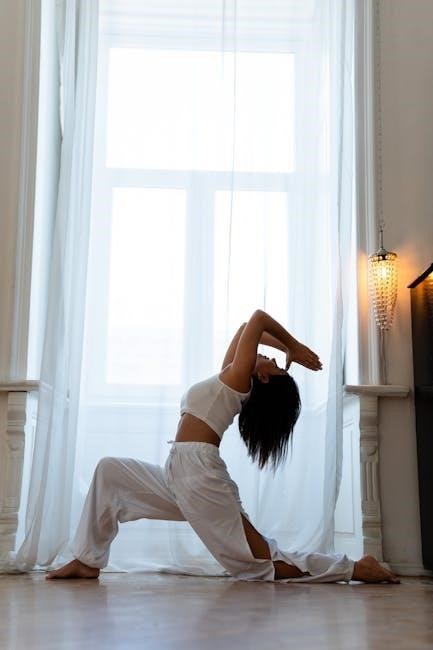
Combining Psoas Stretches with Hip Flexor Exercises
Combining psoas stretches with hip flexor exercises enhances flexibility and strength‚ promoting better muscle balance and mobility while reducing injury risk.
6.1 Dynamic Stretching Routines
Dynamic stretching routines involve active movements that prepare the psoas and hip flexors for activity. These exercises‚ such as high knees and lunges‚ improve flexibility and range of motion‚ helping to prevent injuries during workouts. By incorporating movements like leg swings and step-ups‚ individuals can enhance blood flow and reduce muscle tension. These routines are particularly effective as a warm-up before sports or intense physical activities‚ ensuring the muscles are ready for optimal performance. Regular practice of dynamic stretches can lead to improved athletic performance and reduced muscle soreness.
6.2 Static Stretching Techniques
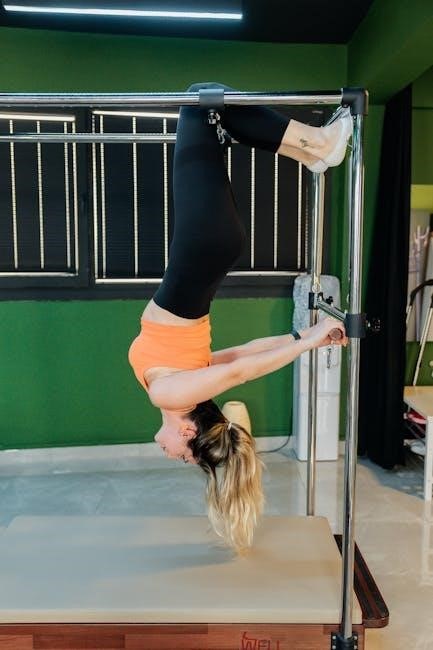
Static stretching involves holding a stretch for a prolonged period to lengthen the psoas muscle. Techniques like the kneeling psoas stretch‚ where one knee is bent and the other is extended‚ help target the muscle effectively. These stretches are typically held for 20-30 seconds to maximize flexibility. Static stretching is best performed after a warm-up or workout when muscles are most receptive. Regular practice can improve posture‚ reduce muscle tightness‚ and enhance overall mobility. Incorporating static stretches into a daily routine ensures long-term benefits for the psoas and hip flexors‚ promoting better movement and comfort.
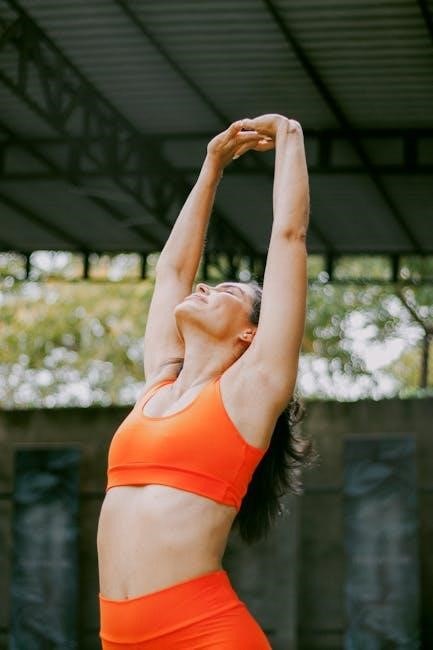
Psoas Stretch PDF Resources
Downloadable PDF guides offer detailed psoas stretch routines‚ including step-by-step instructions and illustrations for effective practice. These resources are ideal for creating a structured stretching plan.
7.1 Recommended PDF Guides
High-quality PDF guides provide comprehensive routines for psoas stretching‚ including step-by-step instructions and visuals. They often cover dynamic and static stretches‚ ideal for both beginners and advanced practitioners. These guides emphasize proper form and safety‚ ensuring effective and injury-free practice. Many include variations like kneeling and prone stretches‚ catering to different fitness levels. By following these structured plans‚ users can improve flexibility‚ relieve tension‚ and enhance overall mobility. These resources are perfect for incorporating psoas stretches into daily routines or post-workout cool-downs‚ promoting long-term muscle health and balance.
7.2 Printable Stretching Routines
Printable psoas stretching routines offer convenient‚ structured plans for daily practice. These routines typically include a mix of dynamic and static stretches‚ with clear instructions and visuals. Many routines are designed for portability‚ allowing users to practice anywhere; They often feature step-by-step guides for stretches like the kneeling psoas stretch and lunges‚ ensuring proper form. Printable routines are ideal for those who prefer physical copies or want to track progress. They emphasize consistency‚ recommending 2-3 sessions per week for optimal results. These resources make incorporating psoas stretches into a daily or post-workout routine simple and accessible.

Safety Tips for Stretching the Psoas
Listen to your body to avoid overstretching. Stop if sharp pain occurs. Use props for support and modify stretches for comfort. Consult a professional if unsure.
8.1 Avoiding Overstretching
Overstretching the psoas muscle can lead to discomfort or injury. It’s essential to stretch gently‚ focusing on a comfortable range of motion. Stop immediately if sharp pain occurs. Use proper form and avoid bouncing movements‚ as they can cause micro-tears. Breathe deeply and smoothly during stretches to maintain relaxation. Keep stretches static and hold them for 20-30 seconds to maximize effectiveness without strain. Pay attention to your body’s signals and adjust the intensity accordingly. Overstretching can counteract the benefits‚ so moderation is key for a safe and effective routine.
8.2 Modifications for Beginners
For those new to psoas stretching‚ modifications can make exercises safer and more accessible. Beginners can start with shorter stretches‚ using props like pillows or straps for support. Reducing the depth of stretches and focusing on partial movements helps build flexibility gradually. Kneeling stretches can be modified by placing a pad under the knee for comfort. Holding stretches for shorter durations‚ such as 10-15 seconds‚ allows the body to adapt without strain. Prioritizing proper form and listening to your body ensures a comfortable and effective practice‚ preventing overexertion and injury.
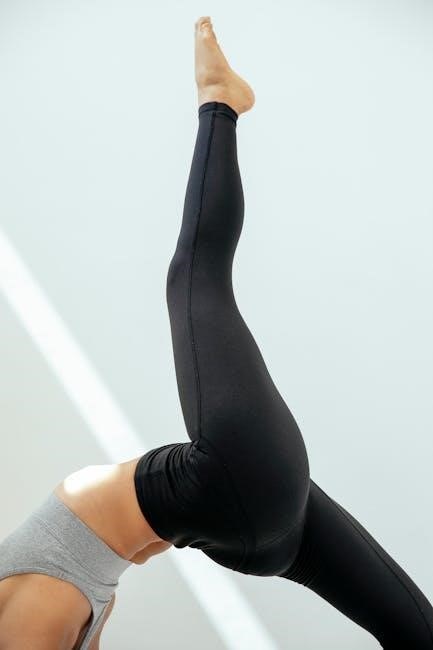
Incorporating Psoas Stretches into Daily Routine
Incorporate psoas stretches into your daily routine for consistent muscle relaxation and improved flexibility. Start with gentle morning stretches and end with post-workout cool-down exercises for optimal results.
9.1 Morning Stretching Routine
A morning stretching routine focusing on the psoas muscle can set a positive tone for the day. Begin with gentle movements like the kneeling psoas stretch‚ holding for 20-30 seconds on each side. Follow with pelvic tilts to release tension and improve spinal alignment. Incorporate breathing techniques to enhance relaxation and ensure proper form. This routine helps increase blood flow‚ reduces stiffness‚ and prepares the body for daily activities. Consistency is key to maintaining flexibility and preventing muscle tightness throughout the day‚ promoting overall well-being and energy levels.
9.2 Post-Workout Cool Down
A post-workout cool down is essential for relaxing the psoas muscle and improving flexibility. After exercise‚ incorporate static stretches like the kneeling psoas stretch or lunges to release tension. Hold each stretch for 20-30 seconds to allow the muscle to lengthen. Deep breathing during stretches enhances relaxation and promotes blood flow. Gentle movements‚ such as pelvic tilts or prone stretches‚ can also be included to soothe the lower back and hips. Regularly cooling down helps prevent muscle soreness and maintains range of motion‚ ensuring the psoas remains flexible and strong for future activities.
Regular psoas stretching improves posture‚ reduces lower back pain‚ and enhances mobility. Consistent practice promotes long-term benefits‚ making it essential for maintaining a healthy‚ active lifestyle.
10.1 Summary of Key Points
The psoas muscle‚ a vital hip flexor‚ significantly impacts posture‚ movement‚ and lower back health. Stretching it regularly improves posture‚ relieves back pain‚ and enhances athletic performance. Various stretches like kneeling‚ prone‚ and lunge variations target the psoas effectively. Strengthening exercises‚ such as pelvic tilts and bridging‚ complement stretching. Combining psoas stretches with hip flexor exercises promotes overall hip mobility. Printable PDF guides offer structured routines for convenience. Safety tips‚ like avoiding overstretching‚ ensure effective practice. Incorporating psoas stretches into daily routines‚ such as morning or post-workout‚ fosters consistency. Regular practice is essential for maintaining a healthy‚ active lifestyle and preventing injuries.
10.2 Encouragement for Consistent Practice
Consistency is key to experiencing the benefits of psoas stretches. Regular practice enhances posture‚ reduces back pain‚ and improves mobility. Over time‚ these exercises become a natural part of your routine‚ fostering long-term well-being. Printable PDF guides offer easy-to-follow structures‚ making it simpler to stay committed. Celebrate small progress and remember‚ every stretch brings you closer to a healthier‚ more active lifestyle. Embrace the journey‚ stay patient‚ and let consistent practice empower you to maintain a strong‚ flexible body for years to come.
